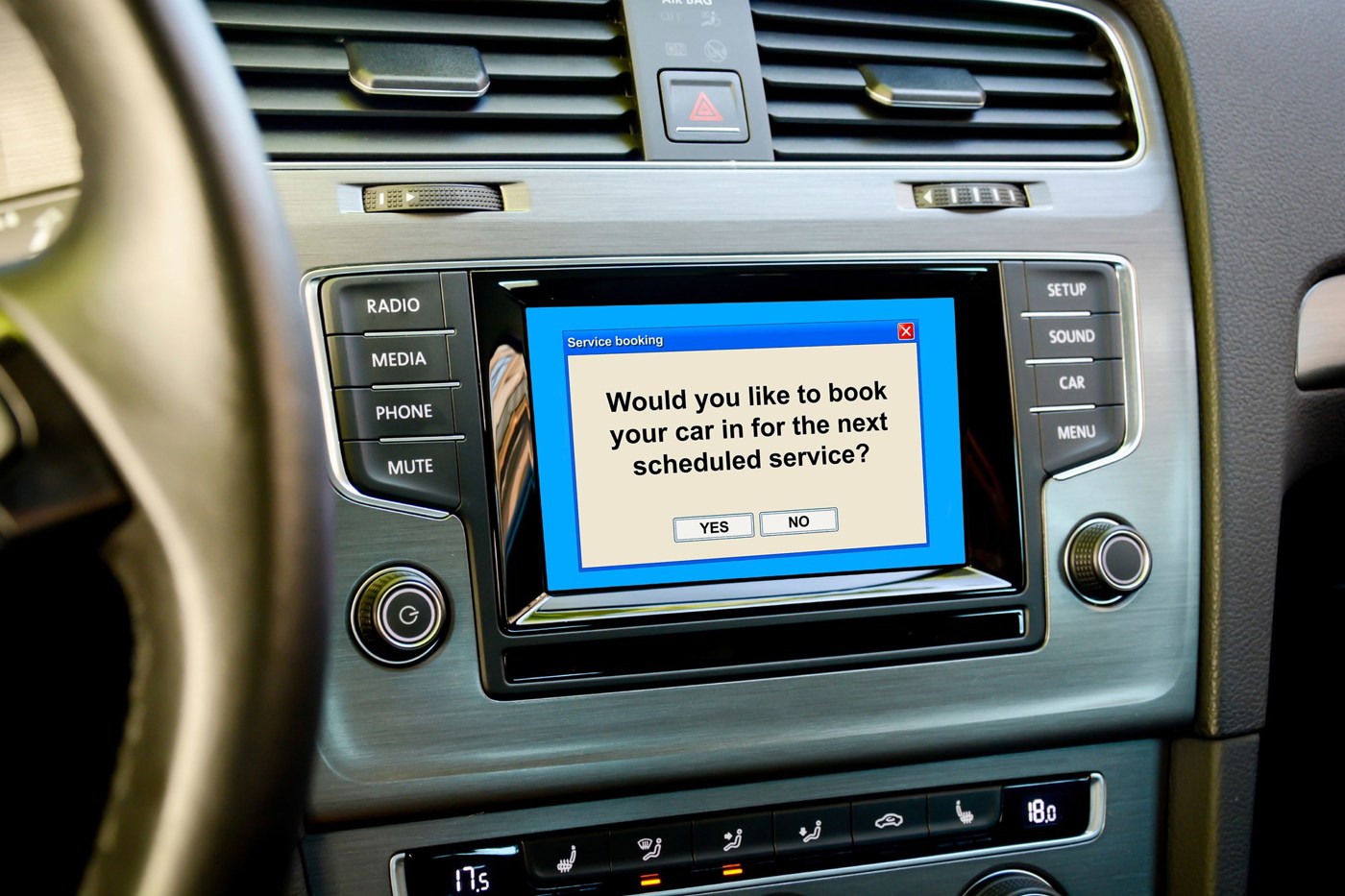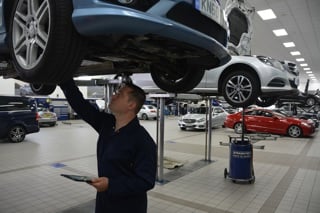Autonomous vehicles, connected technologies, alternative fuels and an end to the traditional service pattern mean uncertainty surrounds the future of aftersales.
Advanced on-board computing pioneered by the likes of BMW and Volvo is already equipping service departments with aftersales leads and data that will allow them to prepare for the work required in a service, drawing details about a vehicle’s status directly from the car to improve efficiency.
The specialist skills required to work oxn alternative-fuelled vehicles are also seeing customers return to franchised outlets for servicing as they seek the security of manufacturer-trained technicians rather than opting for alternative aftersales providers.
However, as alternative-fuelled vehicles do not require high-profit consumables, such as oil, and demand increased investment in training, franchised dealers’ margins may be squeezed. So what does the future hold for an aftersales industry worth £99 billion in the UK?
Darren Lakin, group aftersales director at Wessex Garages, which reported a 49.25% (to 67) increase in sales of the Nissan Leaf EV last year, said: “There is an element of lost profit, but we try to take a pragmatic approach. We have to be part of any cutting-edge development – whether that’s EV or connectivity – or we risk being left behind and having to play catch-up.
“This is the way the industry is going. Customer behaviour and the aftersales environment is changing whether we like it or not. In our view, it’s better to embrace it and adapt.”
Staying connected
BMW and Volvo already offer customers the ability to opt in to a connected servicing scheme, which prompts a driver to notify their “preferred dealer” when work is required, just by pressing a touchscreen.
Addressing the M2M Summit in Düsseldorf last summer, Uwe Krüger, innovation manager of TeleServices at BMW, said BMW’s connected services are able to carry out remote diagnostics once a service is booked, increasing efficiency in the workshop by allowing technicians to prepare for the exact level of service and work required.
“In the past, the service appointment was agreed between the customer and the service adviser on the telephone. In the future, we will see the offer being sent out and agreed in a digital way,” he said.
“Rather than rely on the skills of technicians, we will see the widespread use of virtual assistants in the workshop” Catherine Hutt, Frost and Sullivan
Owners of BMW’s i3 and i8 EV and hybrid vehicles can also view the status of their vehicles’ fluids, brakes and tyres – with green, amber and red indicators – through an app linking their vehicle and smartphone.
Krüger said: “The customer now wants their service doing ‘just in time’. There’s a decreasing willingness to wait and that is an increasing challenge for aftersales departments, but connected technologies can increase efficiencies.”
In 2014, there were 84 million connected vehicles on the world’s roads and Krüger suggested that number would rise by 30% each year, reaching 290 million by 2020. UK manufacturers produced about 800,000 cars with connected technology in 2015, a figure the SMMT expects to double by 2020.
There are currently more than four million connected BMWs on the roads and Krüger acknowledged that the development of certain areas had presented challenges.
While software such as infotainment apps could be easily updated and repaired remotely “over the air” (OTA) he conceded that some remained out-of-bounds due to “security issues”.
Tesla is currently the only manufacturer carrying out OTA firmware updates, a process which benefits its unconventional “non-dealer” dealership network.
However, consultancy Frost & Sullivan has suggested that such technology could lead to a 20% reduction in the number of recalls, 30% in warranty accruals, 10% in warranty revenues and 1-2% in maintenance costs within the next five years.
“EVs are still a specialist area and customers won’t gamble with their maintenance” Darren Lakin, Wessex Garages
Nicklas Danielsson, Volvo’s senior manager for information technology, told AM: “Connected service booking is really going to move the aftersales process forward in the coming years.
“Customers can opt in and pre-select their preferred dealer, so as soon as a message pops up in the car and they select ‘yes’, that dealer can get in touch to make a booking.”
Danielsson said while the connected system could send the vehicle’s mileage and engine hours to the dealership prior to a service, remote engine diagnostics were not yet available, but added: “It’s an area that we are actively looking into.”
Used car operators are now able to benefit from connected servicing technology. Launched in the UK during April, the Smartdriverclub offers motorists with vehicles up to 10 years old the option of a £150, three-year package that uses a plug-in device to relay the status of their vehicle to a smartphone app and put them in touch with a dealer when a service is due.
Nick Chudleigh, regional marketing manager at DMS specialist CDK Global, said dealerships should future-proof their systems to link up with new connected service booking facilities.
He said: “It is important for dealerships to employ future-proof dealership management software (DMS) that is ready to adapt to any potential evolutions.
“We are conscious of how consumers engage with dealers, with non-invasive data already shared to automate processes via mobile devices, online service bookings and direct marketing interactions.
“A foundation for connectivity exists that will develop over the next decade. The key is to keep customers engaged and open to change as new technologies emerge and the ownership experience evolves.”
New technology needs new skills
While investment in DMS developments to accommodate the latest connected technologies may be something for the not-so-distant future, many dealerships are facing the more immediate task of making their aftersales operation EV-friendly.
Jeremy Hicks, managing director of Jaguar Land Rover UK, recently announced that during the restructuring of 118 Land Rover sites and 89 Jaguar sites through its “Arch” concept, JLR had installed new facilities with “huge wiring conduits” in anticipation of the introduction of a new range of EVs.
Nissan and Mitsubishi franchises have already seen a shift in the make-up of their service departments and Devonshire Motors’ dealer principal Nathan Tomlinson agreed with Lakin in suggesting that the investments it had made would become commonplace throughout the industry in the coming decade.
Lakin said a large proportion of a recent £300,000 upgrade to Wessex’s workshops at its Cribbs Causeway site was geared towards EVs. It has introduced more sophisticated diagnostic equipment, three charging points – which can be accessed for free by customers – and special, sectioned-off servicing bays for EVs.
Lakin said: “Our new ramps are specific EV items, which means we have full access to a battery unit.
“We have invested in equipment and made changes to the workshop layout, but the biggest changes have been made in terms of our personnel.
“When you have 6,000V running through a vehicle, you need a focus on training and health and safety. At all times, we have two EV-trained technicians in the workshop and the staff have all received about 40 hours of manufacturer training, most of which is health and safety-related.”
Lakin called for new professional standards and a licensing system to be introduced for EV servicing providers outside the main dealer network. “It could be just a matter of time until someone is seriously hurt,” he said.
Tomlinson, whose Mitsubishi business won the Excellence in Customer Service accolade at this year’s AM Awards, has overseen the provision of four customer charge points, a specialist EV workshop bay with a fast-charge point and extra training for staff. He said: “We are already recruiting apprentices rather than qualified technicians so that we can be certain that they develop along with technology – not only on the vehicle side, but with the administration side of the role too.
“It is already becoming difficult to work around anyone who doesn’t have the necessary skills to keep up with the fast-paced, electronic nature of the modern aftersales operation and I am sure that this will only increase as service times reduce, customer expectations increase and there is more pressure for overhead absorption to support the business.”
Catherine Hutt, Frost and Sullivan’s principal consultant on automotive and transport, expects technology to be used increasingly within workshops to reduce the risk of human error.
She said: “Connected cars will monitor systems in real time and send details of faults and imminent service requirements to a manufacturer or dealer in future, but the technology is set to expand beyond that point.
“Rather than rely on the skills of technicians who will become ever more challenged by new technological developments we will see the widespread use of virtual assistants in the workshop environment.”
Hutt said technicians will be guided through processes on an iPad, connected to the DMS, which will assist in decision-making as well as holding information about stock availability.
The technology has already been trialled by BMW’s Augmented Reality, Volkswagen’s MARTA and Audi’s Cam system.
Hutt added: “Its use is sure to become widespread, reducing training costs, bringing a consistency of decision-making and the ability to record and closely monitor performance.”
‘Customers are not machines’
Krüger warned that no matter how far connected technology progresses, dealers and manufacturers must continue to treat customers as individuals.
Decades from now, when a manufacturer will be able to diagnose and potentially rectify a technical issue “over the air” there will still be those who would rather opt for the traditional reassurance of a face-to-face discussion with a technician.
Krüger said: “Customers are not machines. We are to treat them as individuals with different requirements and demands.
“Individualisation is key in order to increase a customer’s loyalty and commitment to our brand.”
Lakin and Tomlinson both emphasised this point.
Tomlinson said his staff require an extensive product knowledge about the Outlander PHEV, but the advice they can now offer about such a specialist product has helped to develop close relations with customers and guarantee return trade.
Lakin has also found that EV owners are a loyal bunch. He said Wessex was starting to reap the rewards of EV sales and customers who are more inclined to return for their aftersales needs than owners of conventional vehicles.
“We aim for aftersales absorption of 85%, but EV customers always return for their servicing and for advice,” he said.
“EVs are still a specialist area and customers won’t gamble with their maintenance.”
Both Lakin and Tomlinson conceded that profits from traditional consumables would fall with the rise in popularity of alternative-fuelled vehicles and said detailed diagnostics meant EV servicing often took longer and reaped fewer financial rewards. They also expressed concerns about the potential for longer service intervals.
However, Lakin said: “There will always be a need for customers to have a focal point of contact. We have to have the specialist knowledge and the right service to ensure they keep coming back.”
‘Printing’ parts on demand
3D-printing technology could bring small-scale manufacturing into the workshop and revolutionise parts supply, but not any time soon.
A study by Bournemouth University’s Phil Reeves and Dinusha Mendis suggested that 3D printing could “allow parts to be produced to order within the car dealership, repair centre or parts retailer”.
The researchers estimated that up to £26 billion worth of the £121bn global aftermarket parts business could be ‘printed’ on-site. However, using currently available 3D-printers, this would cost up to 100 times more than by conventional methods.
Additive manufacturing (AM) techniques are already being used in aerospace and Formula One, but efforts are being made to reduce costs and
bring the hi-tech, layered construction method to the mainstream. Available from about £1,000, 3D printers can be used to produce small components in the home, usually from plastic.
Bournemouth University’s study concluded that “there is little evidence to suggest that there will be any short-term business opportunities” within the next 10 years.


















Login to comment
Comments
No comments have been made yet.